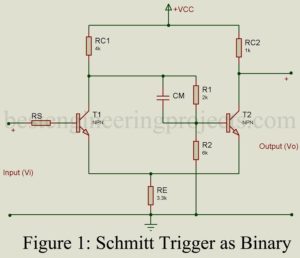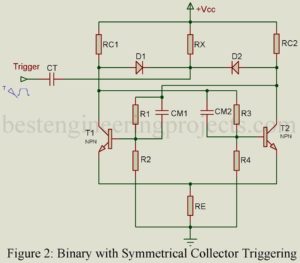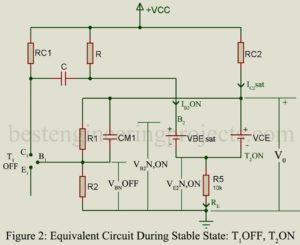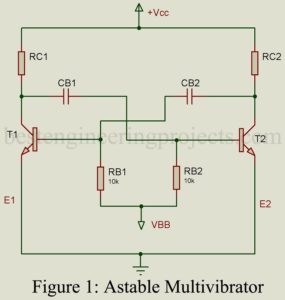Fig 1 gives the schematic circuit of Schmitt trigger. It forms an important bistable multivibrator and differs from the basic Eccles-Jordon bistable multivibrator of Fig 1 in that (i) from output point C2 of T2 to the input of transistor T1 is missing and (ii) the feedback through resistor RE. Using transistors, the circuit is basically an emitter coupled binary. It is called Schmitt trigger after the name of the inventor of the vacuum tube Version. In this circuit, also there are two stable states. This results because of positive…
Read MoreCategory: Nonsinusoidal Generator
Bistable Multivibrator | Binary
Bistable Multivibrator generates a square wave but has two stable states. The circuit stays in one stable say state one indefinitely. Only on application of a suitable trigger pulse, circuit changes to the other stable state i.e. state two. Now again the circuit continues to stay in stable state two indefinitely unless a suitable trigger pulse is applied causing the circuit to revert to the stable state one. Bistable multivibrators are basically of two types: (i) Fixed bias bistable multivibrator (ii) Self bias bistable multivibrator We here take up the…
Read MoreMonostable Multivibrator
Monostable multivibrator generates square wave but it has only one stable state and another quasi-stable state. The circuit ordinarily stays in the stable state. On application of an external trigger signal, circuit changes state to quasi-stable state and remains in the quasi-stable state for a predetermined period of time and then reverts back to the stable state automatically. The time duration of the quasi-stable state is determined by the circuit components and parameters and is independent of the rate of occurrence of triggering pulse. BJT monostable multivibrators may be of…
Read MoreAstable Multivibrator
Fig 1 gives the circuit of an astable multivibrator using BJTs while Fig 2 gives the waveforms of collector voltages and base voltages of the two transistors. Transistor T1 along with collector circuit resistor Rc1 and coupling capacitor Cb1 forms one stage of R-C coupled amplifier. Its output is coupled through capacitor Cb1 to the other R-C coupled amplifier stage formed by transistor T2, collector circuit resistor Rc2 and coupling capacitor Cb2. The output of this second state is coupled through capacitor Cb2 to the input of the first amplifier…
Read MoreMultivibrator | Introduction | Types | Working
Introduction of Multivibrator We have already studied the working of several sinusoidal oscillators. For certain purposes, we need non-sinusoidal generators, also called relaxation oscillators. A relaxation oscillator generates voltage or current which varies abruptly one or more times in a cycle of operation. Typical examples of non-sinusoidal generators are: multivibrator, Schmitt trigger, UJT oscillators, blocking oscillators, saw-tooth (sweep) voltage generators, saw tooth (sweep) current generators etc. Multivibrators are used for various purposes such as generation of square waveforms, frequency counting, frequency division, generation of time delays and storage of binary…
Read More



